Red dust, gold heart
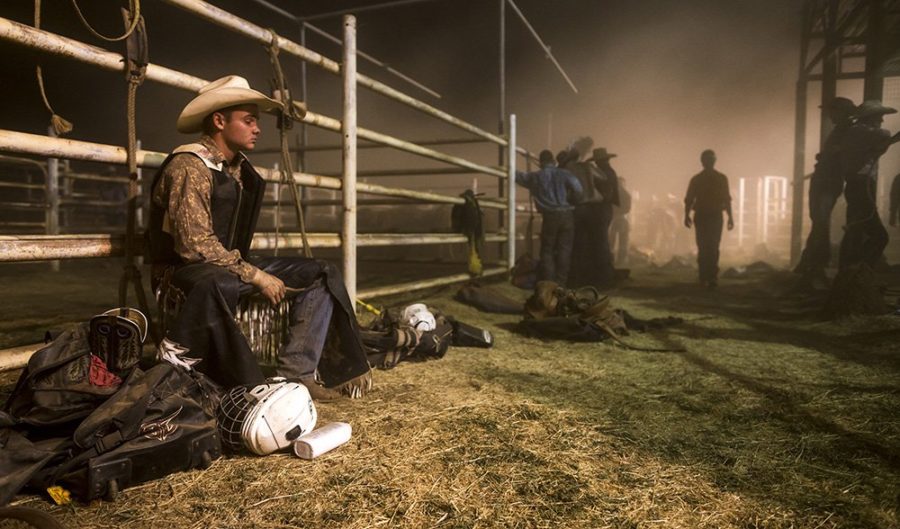
STIRRED UP BY willy-willies and horses’ hooves, the red dust around Tennant Creek swirls over spinifex and snappy gum. Since 1934, this paydirt – the source of Australia’s last major gold rush – has settled on cars, pubs and houses out here. It’s been breathed into the lungs of locals, becoming part of their very being.
To live in one of Australia’s most isolated towns, 1000km south of Darwin and 500km north of Alice Springs, they become as hard as its haematite, and yet as warm as the earth itself. And they absorb its hidden heart of gold.
With a fearsome reputation, Tennant Creek is a town of wild stories, past and present. Tales of alcohol-fuelled violence range from a copper who shot someone over 12 bottles of whisky in the town’s early days, to stabbings, murders and lighthearted banter about a bloke in the pub yesterday swinging punches.
It’s a town that proudly boasts it was founded when a truck carrying beer broke down and people set up camp around it; where police now man the drive-in bottle shops, confiscating alcohol or refusing to let some residents buy any (credited with reducing annual alcohol-related assaults from 460 to 192). It once had a mountain of longnecks higher than the Dolly Pot Inn, and coffins were made from beer crates.
It’s a town where the instruction “turn left at the two dead donkeys” doesn’t sound out of place; where one of the richest goldfields was found by two blokes with one eye between them. Nobles Nob yielded 34 tonnes over the next 45 years, and, altogether, the Tennant Creek area produced 210t of gold, making it one of Australia’s richest fields.
It’s a town with no real reason for being any more. There’s no major industry and the last big mine closed a decade ago, although exploration continues. Mount Isa, more than 600km away, over the Queensland border, long ago took over as the major hub for Barkly pastoralists. Tennant Creek is chock-full of services, though – the shire council, land councils, Aboriginal services – here mainly to serve the 3000 townspeople.
It’s a town where the instruction “turn left at the two dead donkeys” doesn’t sound out of place; where one of the richest goldfields was found by two blokes with one eye between them.
Ask what locals think of the place and you’re as likely to cop an explosion of expletives as people telling you they love it. The latter have moved here from all over the world and talk of how friendly the place is and the willingness of locals to dive in and help. “There’s a great community spirit in town,” says Catholic priest Father John Kennedy, who moved here three years ago. “For example, at Christmas, all the kids in town under 10 or 12 get a present, and that’s been going for 81 years.”
It’s a town that offers a fresh start, and opportunities, with jobs galore for those who want them. However, this also creates a transient town, with many people coming for six months or a couple of years, gaining experience and savings before moving on. One in three locals lived somewhere else five years ago. And Tennant Creek will welcome anyone – famous visitors have included Mother Teresa, Lady Diana and even the Queen, who ate at the Goldfields Hotel in 1963.

Local Aboriginal entertainer and prospector Jimmy Hooker has been chasing gold for 30 years. (Image: Heath Holden)

Jimmy holds a collection of nuggets – a small haul, but at more than US$35 per gram, worth the effort. (Image: Heath Holden)
TWELVE YEARS AGA, a pale Irishman named Bill O’Shea left Ireland mid-winter for this cauldron of central Australia. “It was like stepping off the plane into a blast furnace,” he remembers. “I’d seen photos and that, but I wasn’t prepared for what it was. I loved it.”
Soon after arriving, Bill was taken bush to prospect for gold with Jimmy Hooker, who can’t read or write but can read the country and recite his own poetry. Bill became hooked and now takes others on free prospecting tours. He calls it “scrub therapy” and still works with Jimmy sifting the mullock from old mines, rejoicing in glistering remnants in each pan.
“With the price so good at the moment, you only need 2g a day and you’re making wages,” says Jimmy, who came here for a week in 1968 and has been here ever since. “You could be looking at $30 in that pan there. So if you throw that away each time, it’s a waste. I call it tucker money.”
Jimmy bought his first metal detector in 1977 – a plastic $600 job that was pretty useless. Similar to almost everyone in Tennant Creek back then, he worked at one of the goldmines, and the queue to get these first detectors flowed out the door of the town supplier. “No-one found any gold with them,” Jimmy says, “but there were a few divorces – some of the women couldn’t handle their men being off chasing gold all the time.”
Equipment has improved and Jimmy and Bill now get enough yellow stuff to make it worthwhile. In one recent week they found two ounces, worth more than $2000, although that was unusual. Bill, who speaks with a Cockney accent from his years in London, smiles ruefully. “If you told me 20 years ago that I’d be a gold prospector in the Australian outback…” he begins, then shakes his head and laughs.
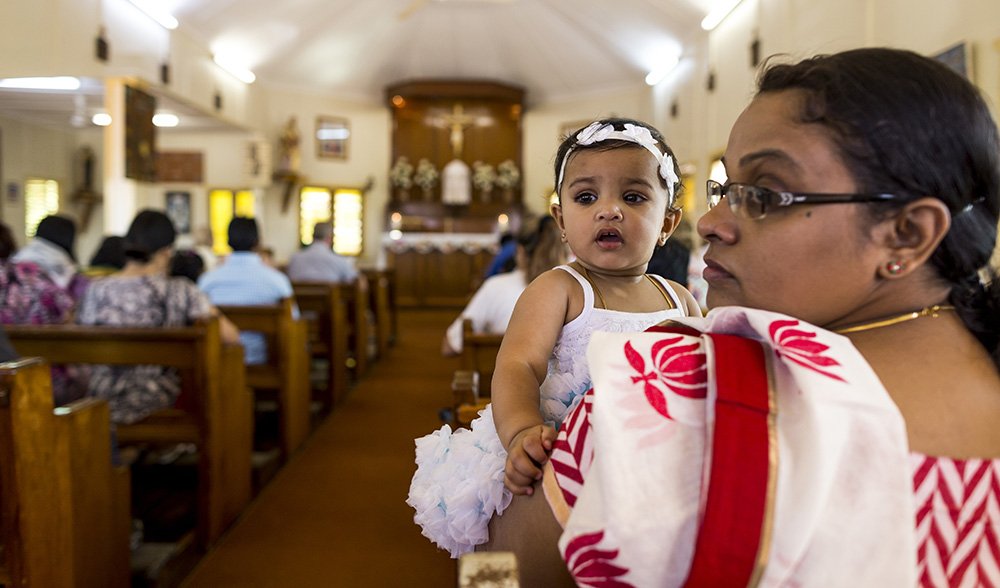
Anu shaji holds baby Tessa for Sunday morning worship in Tennant Creek’s historic Catholic Church, visited by Mother Teresa in 1985. (Image: Heath Holden)
AMONG DRY, STRAW-COLOURED spinifex, purple mulla mulla and scattered termite mounds 10km north of town stands a sturdy reminder of early European settlement. The glorious old telegraph station was built in 1872 as part of a vital communication system. The ‘broadband’ of its day, the telegraph line could get a message from Adelaide to London in seven hours.
The station’s thick stone walls and wide verandahs, with roofs painted in government green, offer respite from the merciless sun. Out here six blokes grew vegies in the dirt and kept livestock, provided rations to the Warumungu people, and relayed morse code messages to the next stations 300km away. Anthropologist Baldwin Spencer, who visited in 1901, was, however, unimpressed, describing it as “the most forlorn and hopeless-looking place imaginable”.
Adventurer Francis Birtles, who cycled from Sydney to Darwin and then down through the Centre along the telegraph line in 1908, was more appreciative: “At Tennant Creek I was most hospitably received… The vegetables were growing as well as I have seen them anywhere.”
According to librarian and local historian Pamela Hodges, the Tennant Creek story could have ended not long after, it if wasn’t for a postmaster at the station. “It wasn’t until 1925, when the postmaster at the telegraph station, William Rabbit, was out shooting euros in behind the Three Sisters, when he came across an outcrop on flat ground, and found gold in the ironstone.” Leases were taken out, and, although the gold wasn’t easy to find in the bullet-hard ironstone, by 1934 the area had a full-blown gold rush – one of Australia’s last.
Pam says the story about the beer truck breakdown becoming the site for the new town appears to be a myth. Instead, she says, the telegraph station was built on an Aboriginal Reserve, so a pub couldn’t be built within 11km of it, leading to the town’s site today.
Like a lot of gold-rush towns, it was wild, with fights over gold fuelled by alcohol. “It was portrayed as the wild west,” Pam says. But at the same time, its heart of gold was shining through, says Roddy Calvert, long-time (but now-retired) Tennant Creek Visitor Information Centre manager, who has lived here since 1981. She says that during World War II, the women in town began to look after army convoys travelling up the Stuart Highway.
“They’d see the great big dust clouds coming, and that would give them time to put the kettles on and bake some scones.” Some of the women then seized the opportunity to flee while their husbands were out looking for gold. “Some of them wanted a lift – they wanted to get out of Tennant Creek. So the husbands didn’t want the convoys stopping and put a stop to it.” Eventually an army camp was set up outside town.
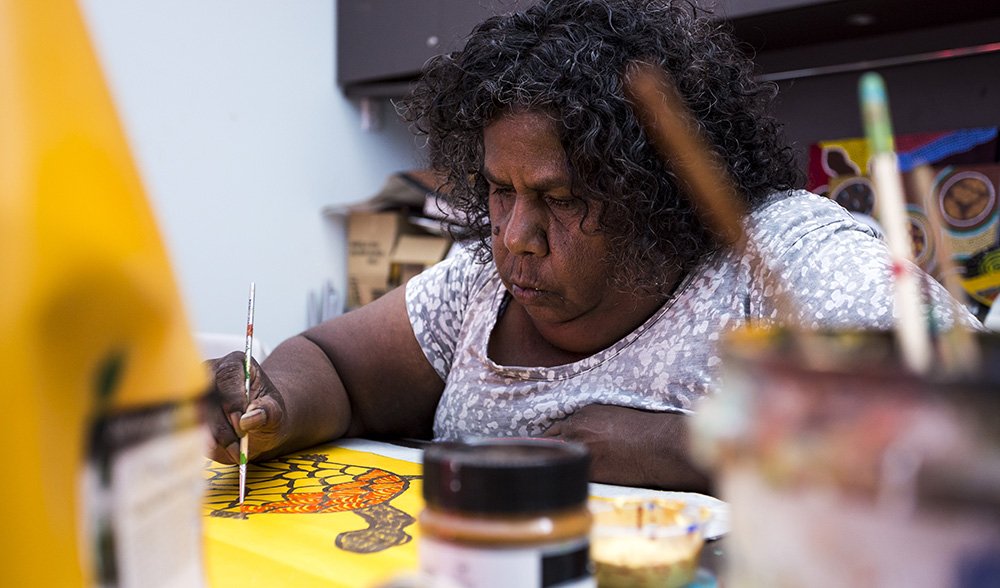
Phyllis Walden, originally from Doomadgee in Queensland’s Gulf of Carpentaria, produces bright artworks at Nyinkka Nyunyu Art and Culture Centre, which showcases local Indigenous art. (Image: Heath Holden)
MEANWHILE, THE TELEGRAPH station itself had closed. It was used for a while as the homestead for the vast Tennant Creek Station. Ken Ford, its current manager and owner, runs about 6000 Brahman and Droughtmaster-cross cows across his “million acres” (4000sq.km). “It’s a bit smaller than most properties around here,” he says.
Ken has lived here for 12 years and loves it. “We’ve got good access and bitumen in every direction so you can get freight from anywhere within a day and a half. We’re only 6km out of town and we have town power, town water and we can even get pizza delivered.”
Making a living on this spinifex, buffel grass and floodout country can be tough at the best of times, let alone when it regularly doesn’t receive the 370mm average, but Ken currently has a spring in his step. “This year we’ve had one of the best seasons…not a lot of rain, but it rained over a few months, so the grass grew, then it grew again and again,” he says. “The global demand for beef is really good at the moment.”
Sitting 376m above sea level, Tennant Creek is pretty flat, with the worn-down jump-ups on the horizon around town looking like a blunted saw blade. A headframe on Battery Hill, on the town’s eastern horizon, is testament to the golden years when pretty much everybody was after the lucrative metal. The battery there was recently renovated, and once again is pulverising the ironstone, at a thunderous volume of 105 decibels, partly for tourists and partly to once more make some money from the paydirt.
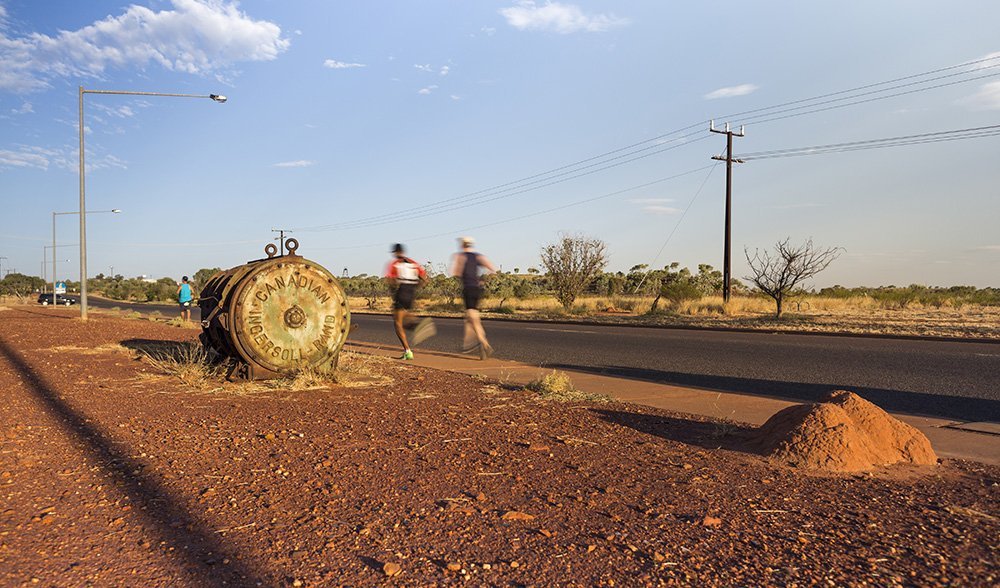
Relics, such as this old machinery along Peko Road, are commonplace around Tennant Creek. (Image: Heath Holden)
THE TOWN ITSELF is surprisingly clean and green, benefiting from thousands of trees planted in the 1980s. A grid-like pattern of roads spreads out neatly from the wide main street, the Stuart Highway. There is a smattering of churches among the mainly single-storey houses, and on a Sunday morn you’re just as likely to hear the twitters of birds and the occasional fiery conversation packed with expletives, among the drone of lawnmowers, dogs barking and the bell-call to worship.
One of the greenest spaces is the garden of Sam Konidaris. Born and raised in Greece, she moved here in 1969 after marrying Jimmy, a Greek who’d become a successful businessman in Tennant Creek. Back then the town had little greenery, and Sam couldn’t speak English, was pregnant and appalled by the heat of summer. She couldn’t even get relief under the shower, because the calcium-rich water came out warm. “I always felt sick,” she says. “Coming here, winter there, summer here – no air conditioning and all around very dry.”
Virtually a recluse for 30 years, Sam was eventually encouraged by her children to start a garden when her husband died in 2003. “When I arrive here, nothing – only a couple of oleanders,” she says. Gardening for hours each day, Sam has created a tropical paradise that has won local awards. Butterflies float among the lady palms, eggflowers, bougainvillea, marigolds, hibiscus, pencil trees, banana plants, vines and creepers. “Every time I go outside into the garden I’m very happy,” she says.
Tennant Creek has a diverse bunch of residents – 50 per cent are Aboriginal and 20 per cent were born overseas, including Indians, Kenyans, Zimbabweans, Malays and Filipinos. The small population with Greek ancestry was boosted two years ago when Nick and Katerina Roditis, formerly of Darwin, set up their Greek cafe because they thought this would be a good place to raise children. “It’s been one of the best moves,” Nick says, between cooking yeros. “The people, the way the community has taken to us, I’ve never felt it anywhere that we’ve lived.”
Katerina, her Santorini-blue eyeshadow and jewellery nicely offsetting sky-blue walls adorned with a Greek flag and pictures of home, agrees. “It’s like a family,” she says. “Even from the first day we opened the shop. All the people came to buy, but also to say, ‘Thank you for opening the shop and for giving us something new.’”

A ringer riding bareback struggles in spectacular style to stay on his bucking ride in the arena at the Tennant Creek Rodeo. (Image: Heath Holden)
THIS SENSE OF INSTANT belonging is echoed by many. “Those of us who live here absolutely love it,” says Kate Foran, manager of the Nyinkka Nyunyu Aboriginal Art and Culture Centre. “You don’t have to be here for three generations before you are a local…it’s very embracing and very welcoming to new people. And also very tolerant.”
At the Culture Centre, which opened in 2003, the ancient art and traditions of the Warumungu and other Aboriginal people are cherished and revered, and women are employed to paint for four hours a day. In broad canvases of gold and orange, red and blue and white, they record inspired works of their people, the land and its rich larder – bush berries, bananas, mangoes, bush apples and oranges.
Warumungu woman Heather Anderson pats her tummy and says she’s hoping for some other tucker soon. “I’m sick of eating kangaroos. I’m sick of eating turkey. I really want emu. They’re hard to get. They run really fast.”
Kate says that, because the area was settled by Europeans only 80 years ago, the ancient cultures here have remained more intact, and most Aboriginal people will primarily speak their own language. But, like so much Aboriginal culture elsewhere in Australia, there’s a blend of the old and new. Now, when local Aboriginal people paint themselves for ceremonies, the traditional ochres are mixed with canola oil, rather than the marrow from emu bones.
Jerry Kelly, the cultural officer at the centre, who grew up on nearby Banka Banka station, shows me the men’s tall headdresses used in dances and ceremonies. “They used to make them out of paperbark. Now they used beer cartons turned inside out,” he says. Once they were decorated with cockatoo feathers stuck on with blood. Now they use cotton wool and glue.
Five years ago, Jerry set up a horseriding school where he teaches locals and takes tourists on trail rides into the scrub around Tennant. “I was born in the saddle,” he says. “I used to ride with the stockmen when I was four or five.”
During his rides he educates about bush tucker and traditional ways of life – giving guests the taste of bush coconut, or washing their hands with soap bush. He ignores old ‘keep out’ and ‘no trespassing’ signs blocking the way to old mine sites. “We can’t read,” he says with a laugh. Dad to a stable of adopted kids, Jerry takes pride in mentoring and teaching Aboriginal youths how to ride and care for horses, so they can get jobs on pastoral properties. “Anyone can ride a motorbike, but this…you can’t teach anyone this in five minutes,” he says.
And the mentoring often goes beyond the horse yard. “I used to train some of them to use fork and knife, too. And just getting up early,” he says. “I also work with Corrections – the kids who are in trouble.”

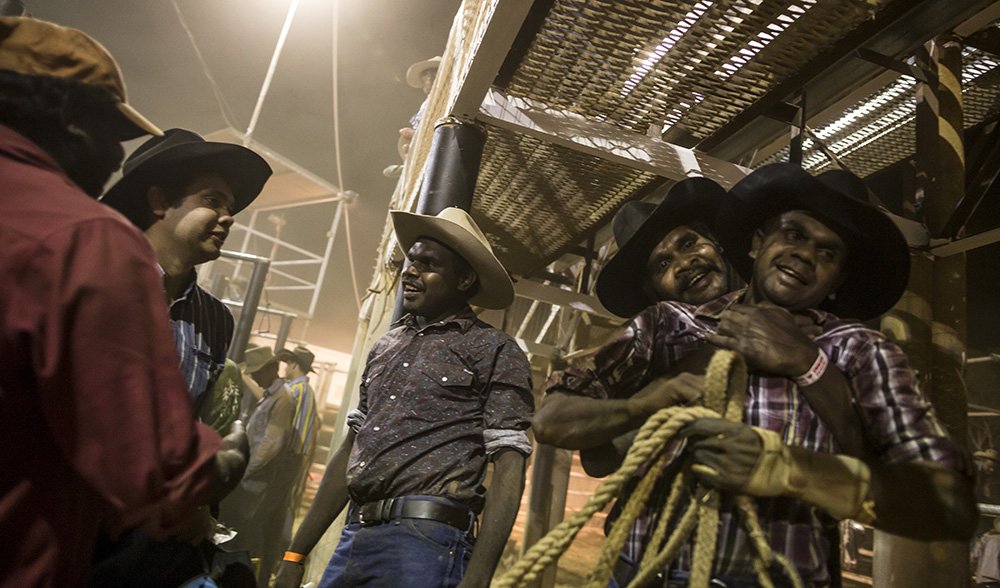
Cultural officer Jerry Kelly (top) teaches local Aboriginal kids horsemanship skills (bottom) to help them find work on cattle stations. (Images: Heath Holden)
JERRY WAS A PROFESSIONAL rodeo rider for a while, until a buckjumper in Camooweal reared in the chute and broke his leg in two places. He was out for six months, but now teaches those same rodeo and campdraft skills to his young charges – some of whom get to prove themselves at the once-a-year Tennant Creek Rodeo.
In the built arena, the dust smothers checked shirts, shiny belt buckles and broad-brimmed hats. Beer cans dot the ground like confetti, while the crowd sings along to Lee Kernaghan’s “The Outback Club”.
In the chutes, where there’s a heady smell of sweat, adrenaline and livestock, one of Jerry’s former students – 25-year-old nephew Mitchell Albert – puts on some borrowed spurs and chaps with blue metallic trim before climbing astride a ferocious-looking bull. This is only the second time he’s done this. The last time was two years ago, and he hasn’t been on a horse this year, let alone a bucking bull weighing half a tonne.
The whites in his eyes clearly visible through the caged helmet, he gives the nod and the chute opens. It’s wild and crazy, with bull spittle and dirt flying, and then – like most riders – he’s bucked off awkwardly in a few seconds, landing heavily in the dust. But then the bull turns, and, seeing the figure on the ground, bucks and stomps on him. Somewhere in the crowd Mitchell’s mother screams. As he tries to stand and get away, the bull turns and hammers him again, like a rag doll.
Finally, the rodeo clowns distract the bull, and Mitchell somehow flees, climbing over the high fence before collapsing on the ground. He lies motionless. His crew attends in a panic and helps him up when his eyes finally open. He’s smiling now and yells a tirade of expletives, then whoops and hollers.
But later, in front of his mother, all he would say was, “I was a bit too slow. I’ve got a sore leg now.” Just like Tennant Creek, he’s as hard as haematite, with a heart of gold.
This article originally appeared in AG#129 (Nov-Dec 129). Australian Geographic and Ken Eastwood thank Travel NT for their assistance with this feature story.

